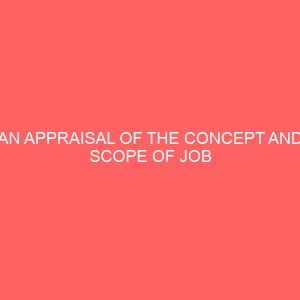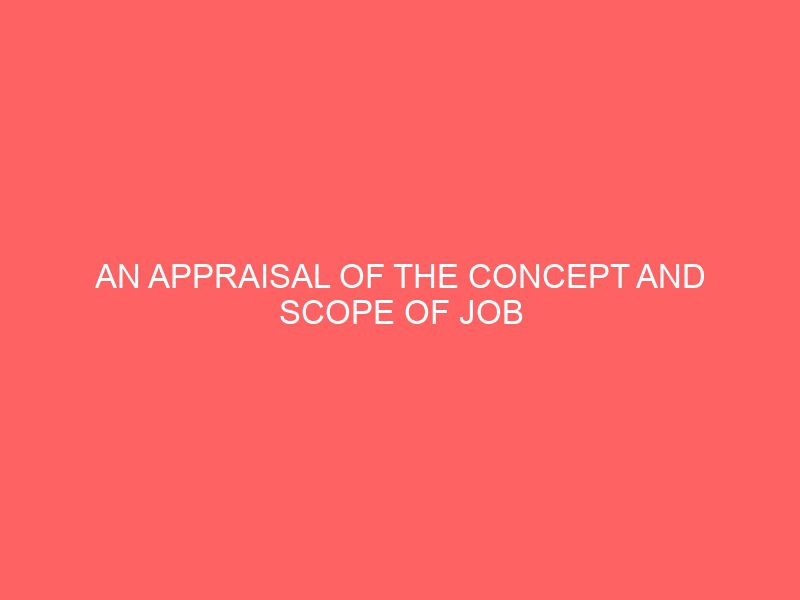Description
CHAPTER ONE
INTRODUCTION
1.1 BACKGROUND TO THE STUDY
The concept of job satisfaction has been developed in many ways by many different researchers and practitioners. One of the most widely used definitions in organizational research is that of Locke (1976), who defines job satisfaction as “a pleasurable or positive emotional state resulting from the appraisal of one’s job or job experiences” (p. 1304).Others have defined it as simply how content an individual is with his or her job; whether he or she likes the job or not.It is assessed at both the global level (whether or not the individual is satisfied with the job overall), or at the facet level (whether or not the individual is satisfied with different aspects of the job). Spector (1997) lists 14 common facets: Appreciation, Communication, Coworkers, Fringe benefits, Job conditions, Nature of the work, Organization, Personal growth, Policies and procedures, Promotion opportunities, Recognition, Security, and Supervision. A more recent definition of the concept of job satisfaction is from Hulin and Judge (2003), who have noted that job satisfaction includes multidimensional psychological responses to an individual’s job, and that these personal responses have cognitive (evaluative), affective (or emotional), and behavioral components. Job satisfaction scales vary in the extent to which they assess the affective feelings about the job or the cognitive assessment of the job. Affective job satisfaction is a subjective construct representing an emotional feeling individuals have about their job. Hence, affective job satisfaction for individuals reflects the degree of pleasure or happiness their job in general induces. Cognitive job satisfaction is a more objective and logical evaluation of various facets of a job. Cognitive job satisfaction can be unidimensional if it comprises evaluation of just one facet of a job, such as pay or maternity leave, or multidimensional if two or more facets of a job are simultaneously evaluated. Cognitive job satisfaction does not assess the degree of pleasure or happiness that arises from specific job facets, but rather gauges the extent to which those job facets are judged by the job holder to be satisfactory in comparison with objectives they themselves set or with other jobs. While cognitive job satisfaction might help to bring about affective job satisfaction, the two constructs are distinct, not necessarily directly related, and have different antecedents and consequences. Job satisfaction can also be seen within the broader context of the range of issues which affect an individual’s experience of work, or their quality of working life. Job satisfaction can be understood in terms of its relationships with other key factors, such as general well-being, stress at work, control at work, home-work interface, and working conditions. A study title “Analysis of Factors Affecting Job Satisfaction of the Employees in Public and Private Sector”, in India concluded that in India Employees tend to love their job if they get what they believe is an important attribute of a good job. Weightage factor of each such attribute based on exhaustive survey has been calculated. Region, sector and gender wise study of job satisfaction has provided consistent picture with respect to distribution of data set analyzed showed that most of the employees in Indian industry are not satisfied with their job except for a few like male in commerce sector and female in education sector. Total job satisfaction level of males is found to be higher than that of woman. Total job satisfaction level in manufacturing sector is found to be very low. Job satisfaction is the level of contentment a person feels regarding his or her job. This feeling is mainly based on an individual’s perception of satisfaction. Job satisfaction can be influenced by a person’s ability to complete required tasks, the level of communication in an organization, and the way management treats employees.Job satisfaction falls into two levels: affective job satisfaction and cognitive job satisfaction. Affective job satisfaction is a person’s emotional feeling about the job as a whole. Cognitive job satisfaction is how satisfied employees feel concerning some aspect of their job, such as pay, hours, or benefits.Many organizations face challenges in accurately measuring job satisfaction, as the definition of satisfaction can differ among various people within an organization. However, most organizations realize that workers’ level of job satisfaction can impacttheir job performance, and thus determining metrics is crucial to creating strongefficiency. Despite widespread belief to the contrary, studies have shown that high-performing employees do not feel satisfied with their job simply as a result of to high-level titles or increased pay. This lack of correlation is an significant concern for organizations, since studies also reveal that the implementation of positive HR practices results in financial gain for the organizations. The cost of employees is quite high, and creating satisfaction relevant to the return on this investment is paramount. Simply put: positive work environments and increased shareholder value are directly related. Some factors of job satisfaction may rank as more important than others, depending on each worker’s needs and personal and professional goals. To create a benchmark for measuring and ultimately creating job satisfaction, managers in an organization can employ proven test methods such as the Job Descriptive Index (JDI) or the Minnesota Satisfaction Questionnaire (MSQ). These assessments help management define job satisfaction objectively. Typically, five factors can be used to measure and influence job satisfaction: Pay or total compensation The work itself (i.e., job specifics such as projects, responsibilities) Promotion opportunities (i.e., expanded responsibilities, more prestigious title)Relationship with supervisor Interaction and work relationship with coworkers.In addition to these five factors, one of the most important aspects of an individual’s work in a modern organization concerns communication demands that the employee encounters on the job. Demands can be characterized as a communication load: “the rate and complexity of communication inputs an individual must process in a particular time frame.” If an individual receives too many messages simultaneously, does not receive enough input on the job, or is unsuccessful in processing these inputs, the individual is more likely to become dissatisfied, aggravated, and unhappy with work, leading to a low level of job satisfaction. Superior–subordinate communication, or the relationship between supervisors and their direct report(s), is another important influence on job satisfaction in the workplace. The way in which subordinates perceive a supervisor’s behavior can positively or negatively influence job satisfaction. Communication behavior—such as facial expression, eye contact, vocal expression, and body movement—is crucial to the superior–subordinate relationship The research therefore seek to provide an appraisal of the concept and scope of job satisfaction with a case study of UAC PLC
1.1 STATEMENT OF THE PROBLEM
The complexity and inability of many firm to measure and determine the job satisfaction level of their employee compounds the ability of the firm to motivate their employees effectively to achieve employee job satisfaction. when employees are satisfied on their jobs they are highly motivated to perform maximally. Many organizations face challenges in accurately measuring job satisfaction, as the definition of satisfaction can differ among various people within an organization. However, most organizations realize that workers’ level of job satisfaction can impact their job performance, and thus determining metrics is crucial to creating strong efficiency. Despite widespread belief to the contrary, studies have shown that high-performing employees do not feel satisfied with their job simply as a result of to high-level titles or increased pay. This lack of correlation is an significant concern for organizations, since studies also reveal that the implementation of positive HR practices results in financial gain for the organizations. The cost of employees is quite high, and creating satisfaction relevant to the return on this investment is paramount. Simply put: positive work environments and increased shareholder value are directly related. Some factors of job satisfaction may rank as more important than others, depending on each worker’s needs and personal and professional goals. To create a benchmark for measuring and ultimately creating job satisfaction, managers in an organization can employ proven test methods such as the Job Descriptive Index (JDI) or the Minnesota Satisfaction Questionnaire (MSQ). These assessments help management define job satisfaction objectively Therefore the problem confronting this research is to appraise the concept and scope of job satisfaction with a case study of UAC PLC.
1.2 RESEARCH QUESTION
1 What is the nature of the concept and scope of job satisfaction
2 What is the effect of job satisfaction on employee performance
3 What is the nature and effect of job satisfaction on employee performance in UAC PLC
1.3 OBJECTIVE OF THE RESEARCH
1 To determine the nature of the concept and scope of job satisfaction
2 To determine the effect of job satisfaction on employee performance
3 To determine the nature and effect of job satisfaction on employee performance in UAC PLC
1.4 SIGNIFICANCE OF THE RESEARCH
The research shall appraise the nature and impact of job satisfaction on employee performance It shall determine measures for appraising the job satisfaction level employees and profer useful information to managers and organisations.
1.5 STATEMENT OF THE HYPOTHESIS
1 Ho Employee performance in UAC is low
Hi Employee performance in UAC is high
2 Ho Job satisfaction level in UAC is low
Hi Job satisfaction level in UAC is high
3 Ho Impact of job satisfaction on employee performance is low
Hi Impact of job satisfaction on employee performance is high







